Low-growing varieties of tomatoes are most popular with most gardeners. What is the attractiveness of this variety, let's try to figure it out.
Plants are considered undersized if their trunk height is no higher than 100 cm.
Conventionally, they can be divided into potted (30-40 cm) and ordinary ones, up to 80 cm. Despite this, the weight of the fruits can reach up to 800 g.

Content
Benefits and types of undersized varieties
- Short ripening period: 90 days on average;
- Easy care, since you do not have to remove the stepsons;
- They do not suffer from late blight and many fungal infections, due to rapid maturation;
- Plants are not tied up;
- All fruits ripen at the same time;
- Cultivated: outdoors, in a greenhouse, on a windowsill;
- They have good taste and shelf life.
To obtain a good harvest, regular watering and fertilization are required.
Tomatoes of this type are subdivided:
- Determinant
Low stem, up to 1 m, dense bushes. You don't have to delete your stepsons. The main stem and stepsons do not grow after the appearance of 2-4 clusters.
- Semi-determinant
The plant grows up to 1.2 m, the growth of the bush stops after the appearance of 10-12 inflorescences. For quick ripening, it is recommended to cut off stepsons.
- Superdeterminate
Bushes are characterized by rapid maturation and a height of up to 1 m. Tomatoes all ripen at the same time in 85 - 95 days and new ones are not formed. Inflorescences are formed in 1-2 leaves.

Soil composition
For high-quality growth and fruiting of tomatoes, the soil must be rich in composition. For planting, a loamy - sandy loam composition of the earth with neutral acidity and a high humus content is suitable.
You can not plant tomatoes for two years in a row in one place. Good predecessors are: cabbage, legumes, carrots, green manure.
In spring, sand, clay, peat and fallen leaves are added to the soil - this will keep moisture and fertilize.
Before planting, the land must be disinfected:
- Potassium permanganate: dilute 3-5 crystals in 10 liters of water and pour at the rate of 30-50 ml per 1 sq. M .;
- Fitosporin: dilute 15 ml of the product in 10 liters of water.
Care
Low-growing tomato species after planting require watering and feeding. Each variety is individual, so you must adhere to the recommendations given in the instructions.
While the seedlings are growing, water it twice a week, avoiding drying out or excess moisture. After planting in the ridge, it is necessary to water it after 3-4 days, in the southern regions it is necessary to water it more often: once every 2 days in the evening. Water should not touch leaves and ovaries - water only at the root.
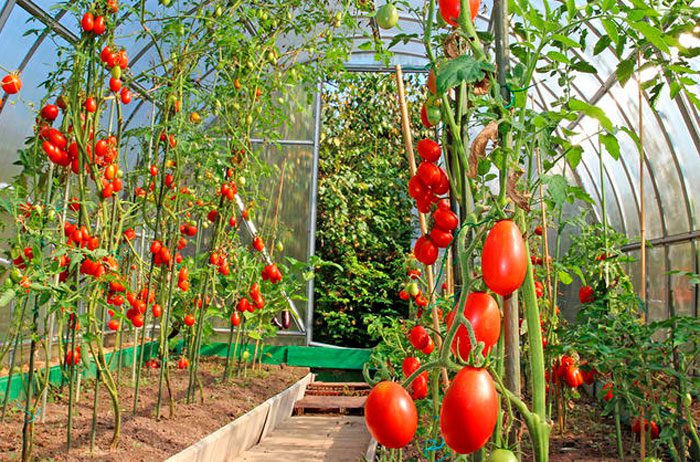
After planting, after 2 weeks, it is recommended to feed, consisting of phosphorus and potassium. In the future, you need to apply after 10 days, alternating mineral and organic fertilizers. For prophylactic purposes, sprinkle with ash or tobacco dust between rows of pests.
The land around the bushes must be loosened 2 days after watering. To retain moisture, mulching is used; for this, sawdust, straw, cut grass are used.
Bush formation
Low-growing plants do not need to be pinned, although there are certain species that require removal of the stepsons. This should be written in the instructions. The fewer the trunks, the faster the fruits will ripen, on the other hand, the more branches, the greater the yield.Varieties that do not form lateral shoots are called standard varieties.
A few rules when forming a bush:
- Leaves below the first brush must be torn off to prevent pests from entering.
- Avoid a large number of leaves inside the bush, as this interferes with the movement of air.
- When forming 2-3 stems under the first ovary, you need to leave 2-3 stepsons.
- After the start of fruit ripening, 2 leaves are removed from the bottom of the stem once a week. Thus, by the period of fruit ripening, there should not be a single leaf on the second ovary.
Standard tomato varieties are most commonly used for outdoor cultivation. Practically, these are all early or mid-season hybrids.
The best varieties of low-growing tomatoes for 2020
Watercolor
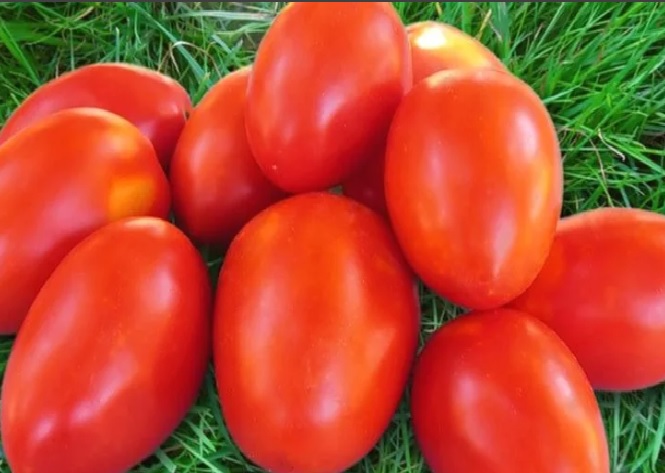
This variety is a hybrid of the Bovine Heart. Plants reach 50 cm, and fruit weight: from 40 - 100 g. Tomatoes with dense skin, deep red oblong color. Tomatoes have a long shelf life and can be processed. The variety tolerates cold well and resists top rot.
Ripening period: 102-105 days.
Advantages:
- High productivity;
- Not susceptible to disease;
- It is used for canning.
Disadvantages:
- Not.
Lord

Determinant species, average maturation. The variety was bred at the Siberian Research Institute. It is resistant to low temperatures, the plant is easy to care for, stepsons do not need to be plucked. Orange-red fruits are round or ovoid. Bush up to 50 cm in height with fruit weight up to 180 g, taste with sourness. Variety Lord is natural, therefore the seeds of the ripe fruit are used for planting.
Advantages:
- Unpretentious care;
- Suitable for planting in any region of the Russian Federation;
- High productivity;
- Used for recycling.
Disadvantages:
- Not found.
Miracle of Siberia

The variety is early, the bush is 70 cm high. Fruits are round, slightly flattened, fleshy with a sweet taste. Up to 5 kg of tomatoes grows per 1 sq. M.
These tomatoes were obtained in Siberia for the cultivation of crops in the regions of the middle zone, the Urals. It is consumed fresh.
Advantages:
- Easy care;
- Fruits weighing up to 200 g;
- Low temperature resistant.
Disadvantages:
- Not recommended for blanks.
Adelina
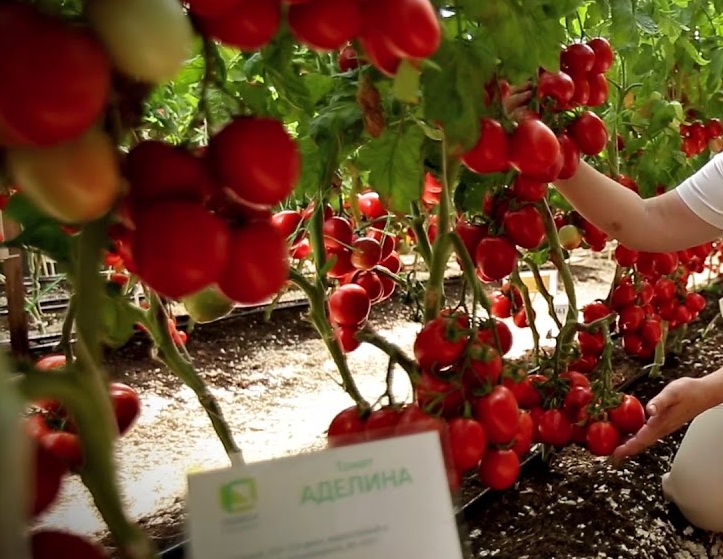
The variety is considered unpretentious. The height of the bush is up to 50 cm, with the formation of 4-5 brushes, growth stops. The fruits are oblong and bright red in color. The weight of one fruit is not more than 100 g. This version of the tomato can be recommended to those who do not have the possibility of constant care. Tomatoes tolerate heat well, due to their dense skin, they are suitable for canning.
Ripening period up to 115 days.
Advantages:
- Drought resistant;
- Do not require long-term care;
- Suitable for workpieces.
Disadvantages:
- Sensitive to excess moisture.
Buyan

The Fighter variety was bred by breeders from Novosibirsk and included in the State Register under this name. Buyan is already a popular name. Tomatoes are suitable for cultivation throughout the Russian Federation. Plants are low, only 40 cm, do not require formation.
The variety is early maturing, the fruits can be removed after 95-100 days, thanks to this, the bushes do not have time to undergo phytophthora. The fruits are red and yellow, suitable for conservation.
Advantages:
- Drought and low temperature resistant;
- Not susceptible to tobacco mosaic and does not suffer from late blight;
- The bush does not need to be shaped.
- Suitable for blanks and long-term storage.
Disadvantages:
- With a lack of sun, the seedlings must be supplemented.
The seed catalog of the 2020-21 season offers popular and familiar tomato varieties and new ones bred by breeders. We offer a description of some types of tomatoes for cultivation in greenhouses and outdoors.
Banana feet
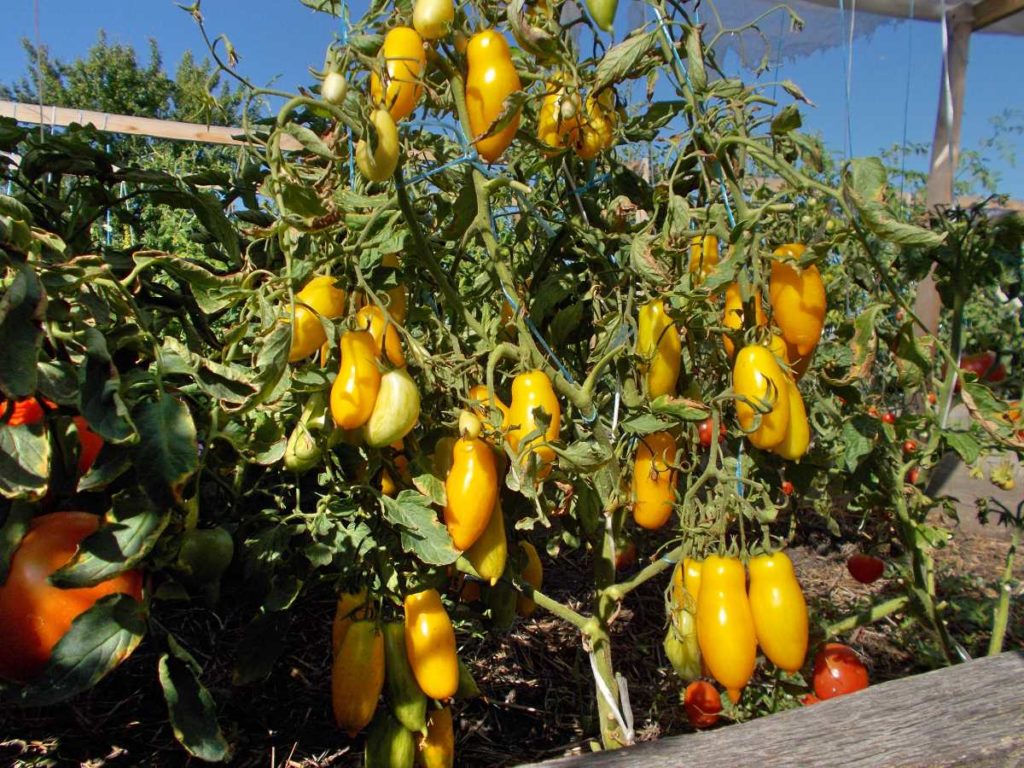
Bushes do not need constant pinching, stepsons need to be plucked out to the first ovary. The stem grows up to 80 cm, the fruits are oblong, yellow, shaped like bananas. The mass of one tomato reaches 75 g, they are well transported. You can grow through seedlings and seeds. Tomatoes are drought tolerant.
Advantages:
- Do not get sick;
- Heat resistant;
- The fruits are delicious;
- Suitable for workpieces;
- The possibility of growing in a seedless way.
Disadvantages:
- Not identified.
Visibly invisible
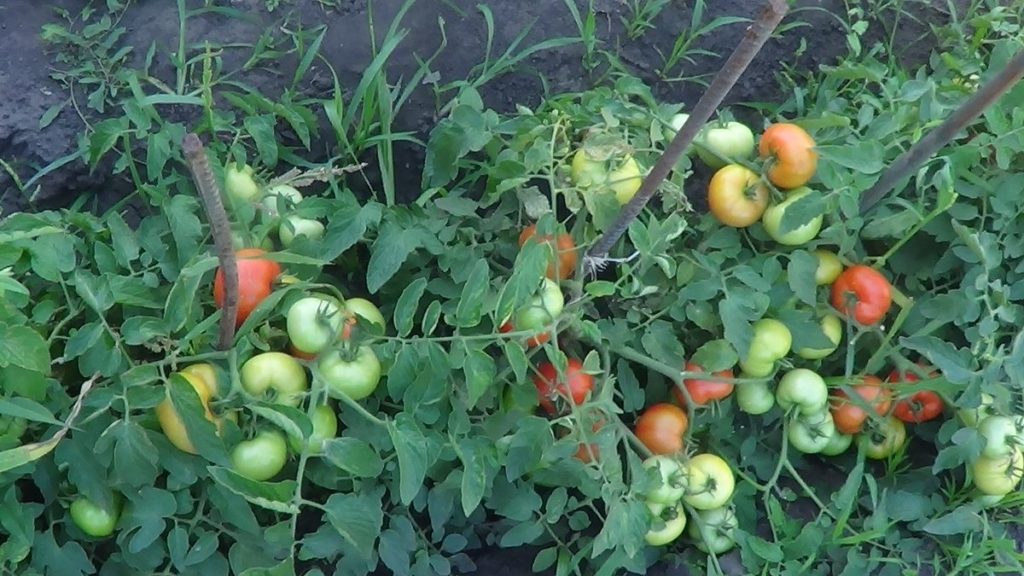
This is a determinant variety, the plant is only 60-90 cm high. Fruits appear early, after 85-100 days.
Tomatoes are large up to 300 g, flattened, very good for workpieces, do not lose their appearance during storage and during transportation. With proper care, one bush yields up to 4.5 kg. In the southern regions, tomatoes do well outdoors.
This variety thrives in a greenhouse, formed by a 3-stem bush and even on a 2-stem balcony.
Advantages:
- High productivity;
- Can be grown in urban environments;
- Immune to disease.
Disadvantages:
- Proper care is required.
Eternal Call

This cold-resistant variety belongs to the Siberian selection. The bush is determinate. The fruits are round with a ribbed surface at the stalk, the weight can reach 0.5 kg.
Tomatoes are consumed fresh, they retain their appearance during transportation.
Ripening period: 100-120 days.
Advantages:
- Well tolerates cold weather;
- Large fruits;
- Unripe fruits are transported without damage.
Disadvantages:
- Not recommended for blanks.
Summer resident
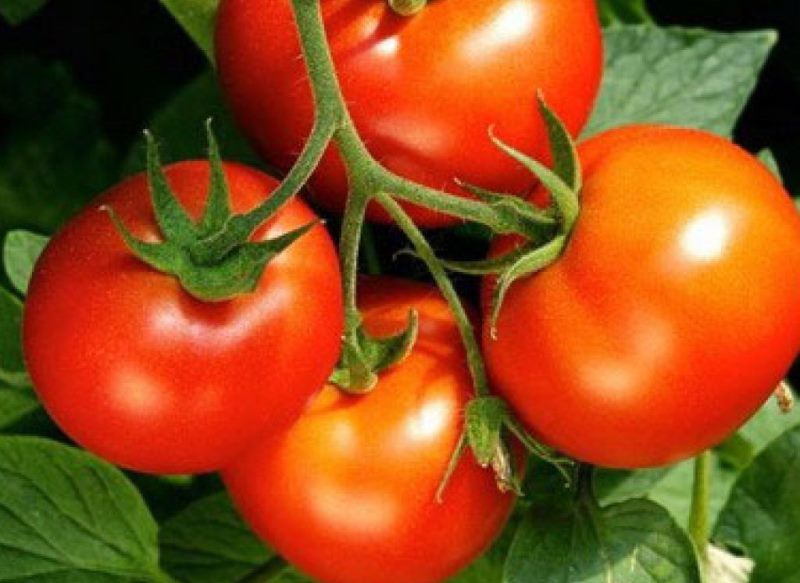
It is a determinant variety with an early maturity. In the open air, the plant reaches 50 cm, under the film it grows 20 cm higher. Tomatoes do not need to be pinned, the branches can bend under the weight of the fruits, so it is necessary to tie up the bushes.
Tomatoes ripen in 105 days.
If you plant 7-8 plants per 1 sq. M, then 4 kg of tomatoes can be obtained from one bush. In the greenhouse, the weight of the fruits reaches 100 g. The Dachnik variety does not suffer from fusarium and apical rot; it has an average resistance to other infections. Universal application: fresh, for canning.
Advantages:
- Stable yield regardless of the weather;
- Resists diseases;
- Early ripening.
Disadvantages:
- Not found.
Jalpa
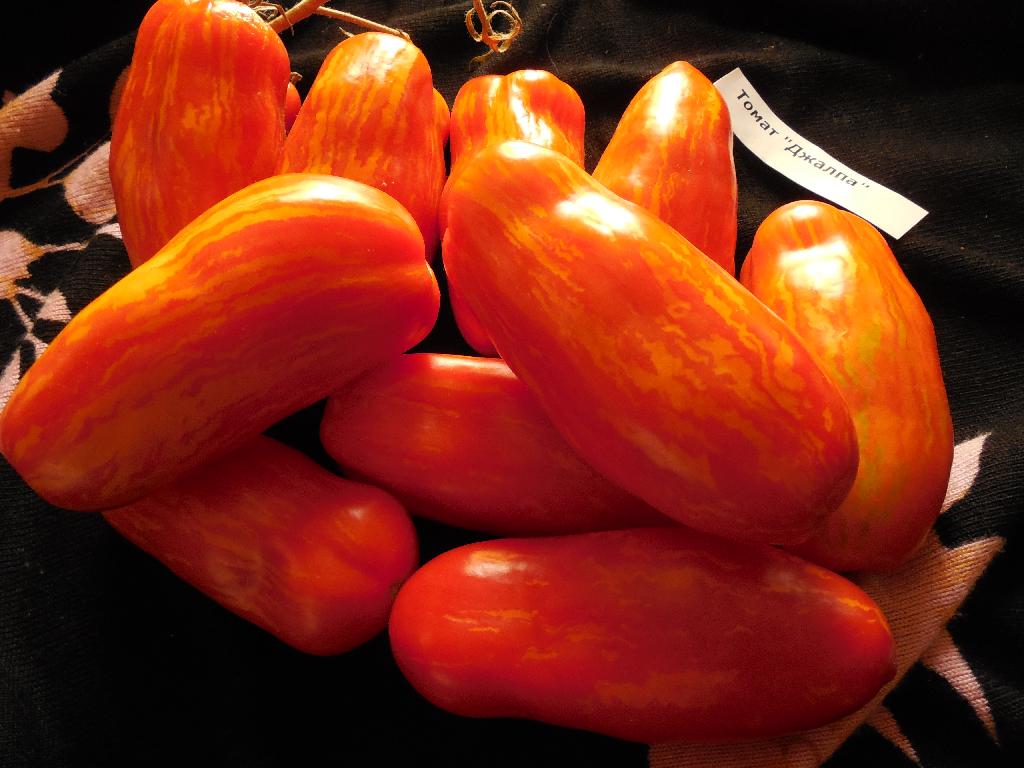
This is a relatively young, but already popular tomato. Bushes up to half a meter high, with 6-8 fruits per cluster. The culture does not need pinching, grows on the street, is not afraid of temperature changes.
Fruits are elongated with light streaks, fleshy, tasty. They are used for salting. Reviews are only positive.
Advantages:
- Easy care;
- Cold resistant;
- Suitable for canning.
Disadvantages:
- Not found.
Mongolian dwarf

This is a super early ripening variety with a high yield, weighing up to 200 g (surprising for such undersized ones). Bushes 10-15 cm, creeping. Tomatoes ripen from the beginning of planting until the very cold, thin-skinned, delicious. The variety is adapted for cultivation in areas of risky farming. This type of tomato is not included in the State Register of Breeding Achievements, it can only be purchased from private breeders.
The tomato is of natural origin, its seeds can be taken for planting next season.
Advantages:
- High productivity;
- Fruit ripening during the entire growth period;
- Does not suffer from late blight;
- It is versatile in use: fresh and for processing.
Disadvantages:
- Can only be bought from private collectors.
Moscow
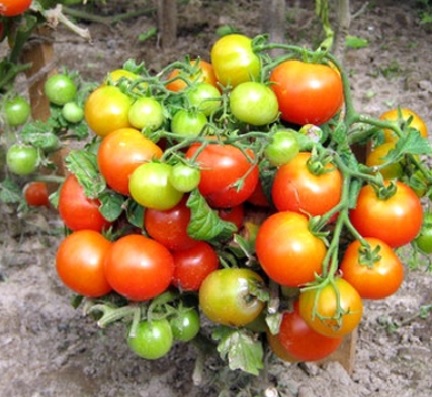
The author of this variety is the breeder Myazina L.A. Moscow is included in the State Register of Seeds in 2017. The plant is determinate, the bushes are low, only 50 cm, grow well in open ground and under the film. Ripening period 115 days.
The first inflorescence appears under the 5th leaf. Fruits of red color, round, weighing up to 90 g. Care is minimal: does not require pinching, is not susceptible to diseases.
Advantages:
- Simultaneous maturation;
- Easy care;
- Rarely get sick;
- Well transported;
- Universal use: fresh, for conservation.
Disadvantages:
- Average yield compared to hybrids.
Pink leader

Developed by domestic scientists and included in the State Register in 2008. The culture can be cultivated throughout the territory of the Russian Federation, grown by seedlings and seeds.
The fruits ripen in 90 days.
Bushes grow up to 50 cm, up to 5 raspberry-colored fruits ripen on each brush. The mass of one tomato reaches 170 g. The variety is frost-resistant, tolerates temperature extremes, and resists many fungal diseases.
The pink leader is considered very prolific, 3-4 kg of fruit can be harvested from one bush, no need to pinch.
Advantages:
- High-yielding;
- Resistance to temperature fluctuations;
- Rarely sick;
- Compactness - can be grown even on the balcony;
- Easy care.
Disadvantages:
- Small fruits;
- Not used for conservation.
The article provides a description of the most popular varieties of low-growing tomatoes. Most of them, when properly cared for, produce good crops outdoors and in the greenhouse. The choice is yours!












